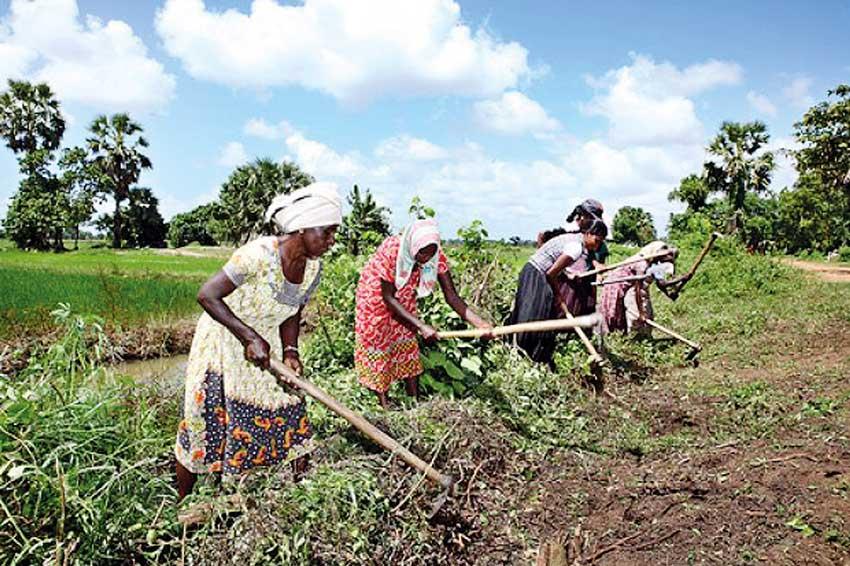23 Jun 2020 - {{hitsCtrl.values.hits}}

Sri Lanka’s per capita income is US$ 3,852 which is not sufficient to live a happy life
 Giving solutions to economic problems is a task which should receive a high priority to resolve socio-economic problems of the public. Giving a higher income to the hands of the people would resolve most of the problems in the society.
Giving solutions to economic problems is a task which should receive a high priority to resolve socio-economic problems of the public. Giving a higher income to the hands of the people would resolve most of the problems in the society.
People would fall in to hardships when there is no sufficient income received by them. A sufficient economic growth is required in order to raise income received by the individuals of the society. Hence, a priority is required to maintain a higher economic growth, and for that a set of appropriate policies has to be implemented.
A set of short term and long term economic policies can be considered for implementation to achieve and sustain a higher economic growth.In an economy the level of economic growth is based on the level of production, i.e., the value addition to the economy. For a production process to be taken place in the economy, people have to engage in some kind of economicactivity rather than remaining idle. In other words,people should not wait until the government provides their necessities free of charge. People should engage in production. Policy makershave to make available relevant economic policies in order to keep the people engaged in the process of production. This is the policy package we require to achieve a higher economic growth.
Per capita income
It is to be noted that Sri Lanka’s per capita income is US$ 3,852 based on which the country is classified as a middle income country. This income is not sufficient to live a happy life. This level of income can be compared with the high income happy countries in the world.
For instance, the top 10 happiest countries in the world are receiving more than US$ 40,000 per capita income for a year. Sri Lanka’s per capita income has to be increased to a level of US$ 12,376 in order to reach high income status. That is the minimum.
But the people in the happiest countries in the world are receiving more than US$ 40,000 per capita income per annum. Sri Lanka may require another 15 years to reach a high income receiving country provided that the country has an 8 percent annual economic growth. Since the current economic growth is around 2 to 3 percent, it may require a longer period to be a high income receiving country.
Funds for investment
We need investments in order to acceleratethe production process, i.e., economic growth. For investments we need funds. Thus, solving the funding problem for investment is the solution for the problems faced in achieving
economic growth.
We need to implement appropriate policies to make available sources of funds required for investments. Sources of funds for investmentsfor a country can be made available internally and/or externally. Internally, individuals and the establishments available in the country should make available required fundsby way of their savings.
Lending capacity of the banks is limited to their resources that are savings of the people. In Sri Lanka, savings collected by the banks are not sufficient for extensive lending.
Creation of money for lending has a limit. Then the amount of money available locally is not sufficient to meet entire fund requirement for investments. Government too has dis-savings. Hence, it is clear that country’s total fund requirement for investments cannot be met only by local savings or by the banking system. Therefore, the country requires external sources of funds to promote investments to achieve a sufficient level of economic growth.
In addition, banks can create money to some extent. Savings created by the people in the banking sector is the basis for creation of money by the banks. Since the internal savings are limited, banks can create a limited amount of money. The insufficient savings created by the people are one of the problems faced by Sri Lanka in making available a sufficient level of funds for investments.
Over creation of money by the banking system would be inflationary and the adverse effects of such situations can be seen internationally in the history as well as currently. One example is the Zimbabwe, which created unlimited money for activities of the people in that country resulting in a series of unresolved economic and political hardships.
Hence, making available of investible funds by way of creating money by the banking system has a limit. Bank’s lending to consumption purposes has to be limited since it would have adverse effects on the inflation and external reserves as there will be a higher demand for imports.
For instance, if Sri Lanka needs to achieve an economic growth of 8 percent, assuming 4: 1 of input output ratio, it needs a 32 percent of investment as a percent of GDP. Sri Lanka’s current (2019) domestic savings rate is 21.3 percent and the national investment rate is 27.4 percent. This shows that there is a 6.1 percent gap between savings and investment for the current level of economic growth of 2.3 percent.
If economic growth is expected to be 8 percent, the gap to be bridged would be much higher than 6 per cent. If so we will be required to find external funding to fill this funding requirement for investments of the country.
Availability of external funding sources
What are the external sources of funds available to us? We can borrow from the international market or from other external bi-lateral and/or multi-lateral sources. Or we can rely on external remittances and external investments (so called foreign direct investments (FDI)).
If we consider borrowings have adverse repercussions on the economy we need to rely on other funding sources. Since Sri Lanka’s foreign remittances are limited and not sufficient to meetexternal funding requirements fully, the most welcomed source of external funding seems to be the securing of
funds from FDI.
Sri Lanka currently receives US$ 6.7 billion of remittances and US$ 1.2 billion of FDI, amidst US$ 23 billion of domestic investments showing an insufficient amount of external finances for investments. Sri Lanka’s exports are stagnated and imports are rising over the years thus creating a trade deficit and hence a dis-savings. Remittances are not sufficient to offset the impact of trade deficit. Therefore, much emphasis is required to promote
exports as well.
Since FDI financing is too low we need to think of ways of attracting FDI. In order to attract FDI we need a series of remedies. Maintenance of a conducive economic and political environment is a prerequisite for attracting FDI. Making available a suitable legal and labour supportive conditions for foreign investors, maintenance of law and order properly are some of the prerequisites
in this regard.
If investments through multinational companies are not suitable for us, we need to implement suitable revisions to procedures in receiving FDIs. Lessons from countries such as China and Singapore which maneuvered foreign investments to be matched with their country situations can be learnt by us too in this regard. Today, most of the higher education systems and large scale production systems in these countries are run by multi-national companies. Since Sri Lanka’s locally available funds for its investments to achieve a higher economic growth are not sufficient willingly or unwillingly we may have to go for foreign investments. Vietnam, a recently liberated country from the war has gone successfully for international markets through foreign investments.
Promoting export market is another way to find external finance. However, there are limitations for immediate promotions to our export market. Lack of advanced technology and human skills to produced high tech cost effective products demanded by the world are some disappointing factors in this regard. The solutions to these types of problems cannot be given in a short period. As a permanent solution to these, reforming our education and training systems is required.
A revision to education system involved with technology is required to win the competition for products in the advanced world market. This may take time. Countries like China and Singapore relied on FDI at the initial level of takeoff of their economies, but now heavily relying on export market to maintain a high income level to their countrymen.
We too should attempt to increase FDI and promote export market gradually based on them.
Promoting external investment is a must for the requirements of winning the world market and thereby promoting the economic growth while resolving issues relating to poverty of the people.
Palming the blame to banking sector for not supporting the production process by way of cheaper credits is not 100 percent reasonable. The disappointing features in the product market of the country are a result of a series of deep rooted weaknesses, which require implementation of careful step by step resolutions (reforms).
We should not forget that the Central Bank of Sri Lanka has addressed what we need to be done in summary in the Box Articles 3 and 7 of its Annual Report for 2019.
(Dr. W. M. Hemachandra is a former Assistant Governor of the Central Bank of Sri Lanka)
25 Dec 2024 2 hours ago
25 Dec 2024 2 hours ago
25 Dec 2024 3 hours ago
25 Dec 2024 4 hours ago
25 Dec 2024 5 hours ago